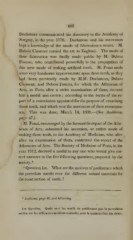Page 446 - My FlipBook
P. 446
442 —
Duchateau communicated his discovery to the Academy of
Surgery, in the year 1776. Duchateau and his successors
kept a knowledge of the mode of fabrication a secret. M.
Dubois Chement carried the art to England. The mode of
their fabrication was finally made public by M. Dubois
Foucou, who contributed powerfully to the propagation of
this new mode of making artificial teeth. M. Fonzi made
some very handsome improvements upon these teeth, as they
had been previously made by M.M. Duchateau, Dubois
Chement, and Dubois Foucou, for which the Atheneum of
Arts, in Paris, after a strict examination of them, decreed
him a medal and crown ; according to the terms of the re-
port of a commission appointed for the purpose of examining
these teeth, and which was the maximum of their recompen-
ses. This was done, March 14, 1808. (See Audibran,
page 47.)
M. Fonzi, encouraged by the favourable report of the Athe-
neum of Arts, submitted his invention, or rather mode of
making these teeth, to the Academy of Medicine, who after
after an examination of them, confirmed the report of the
Atheneum of Arts. The Society of Medicine of Paris, in the
year 1812, decreed a medal to any one who would give cor-
rect answers to the five following questions, proposed by the
society.*
" Question 1st. What are the motives of preference which
the porcelain merits over the different animal materials for
the construction of teeth. ?
* Audibran, page 49, and following.
Ire. Question. Quels sont les motifs de preference que la porcelains
mcrite sur les ditferenles matieres animates pour la construction des dents.


